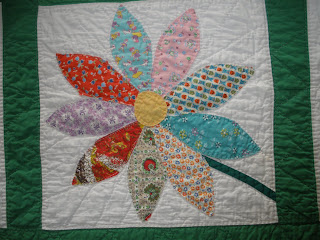Time to get busy--- but first, some thoughts on the ripping process. I like this Clover ripper. It has a flat handle. The other one with the rounded handle was cute but it was always rolling onto the floor.
I had a friend who would use the ‘pick’ on each stitch and pull the entire length of thread through without breaking it! I didn’t dare ask if she was planning to use it again. Some use the pick to go under about every 3rd stitch, break it and then pull the bobbin thread off in one swoop.
I’ve used various methods but for me, using that sharp inner curve is much more efficient for this type of work than using the ‘pick’ part.
 |
| The key is in the angle of the tool and the tension you provide. |
Either way, you know what they say. The proper tools make any job easier. Old, dull rippers make good stilettos but how many of those do you need? Treat yourself to a new sharp one every so often. (I just had a flash-back of my mom using a single edge razor blade to take off seam tape from a hem- maybe it's because my hands look like hers!)
Brief (but timely) Detour -- ...I took a break from working on this post and I was sort of cleaning the ledge (blowing at the dust) on which I have lots of sewing doo-dads displayed. It was feeling too cluttered so I started moving things around - and two items caught my eye; two early versions of seam rippers.
The one on the right instructs you to use it in place of the needle on your sewing machine. You "insert Rip-a-Seam in first knot of stitch and lower foot. Then, operating machine at moderate speed, follow stitching closely" . Have you ever? I can't image that . It does warn that on sheer or closely woven material it may fracture thread in the weave. I think I will have to give it a try.
The other is Mi Ladies Seam Ripper - ooh-la-la....how very French! Or something. But it's just a glorified single edge blade like Mom used! A bit safer, though.
Okay, that was fun..... but back to work
So now I have a growing pile of emancipated rectangles
Time for a bath.
I use Orvus. It’s actually a horse shampoo and I buy this 120 oz.size at a pet supply store. Smaller portions are often sold in quilt shops ($$$). It’s not a detergent but a soap and leaves no residue. It’s concentrated, biodegradable, and contains no phosphorous or brightening agents. I use it to prewash all my quilt fabrics before I put them on the shelf and to wash vintage or completed quilts. It can be used for delicate needlework, fine linens and silks. The main thing is not to use regular laundry products if they contain brighteners or bleach of any kind. Check the label.
I like my big white bowl from the 99 cent store. I use it a lot because I can easily see the dirt (or dye) as I work.
The top I'm working with contained shirtings that are somewhat discolored but I am not using any restoration products because I want to retain any authentic qualities of ‘oldness’ including the discoloration.
I separate by color and let it all soak, agitating with an old wooden spoon occasionally and following with numerous clear rinses as seen below in the beautiful blue batch.
Finally, I either spin them out in the washer or just press out excess water and lay them flat on a towel.
By the time my iron heats up and I check my email :) I can start pressing them while still damp.
Ahhh. so satisfying. At least for me.......
If you’ve stayed with me to this point, I KNOW some of you are saying “This chick is crazy!” but I also think there might be a few of you saying, “Wow! I can relate to Jean the Ripper. I am not alone!” A comment from a non-quilting friend in an early post asked simply, “Why do you do this?” It forced me to think about the reasons which I'll share in the next post:
Ripping- Part III: Why & Now What?
























































